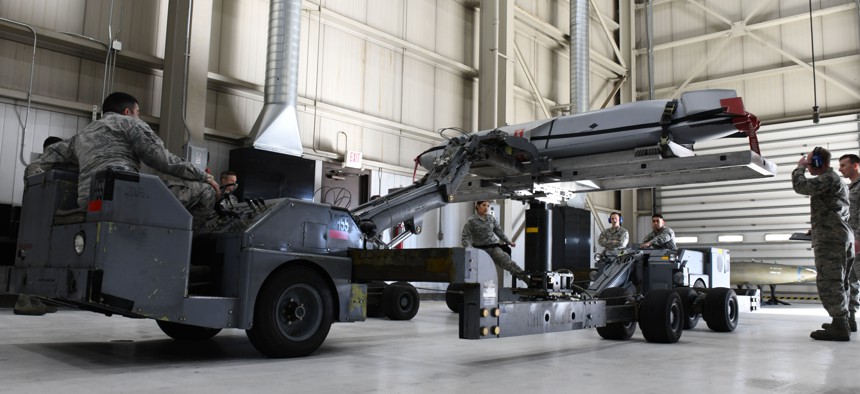With China, Russia in Mind, Pentagon Adding Stealthy Cruise Missiles
Lockheed Martin is building a new factory to accommodate the military’s demand.
The Pentagon is boosting its stockpile of a stealthy long-range cruise missiles that might be critical in a war with China or Russia.
The demand for the weapon — called the Joint Air-to-Surface Standoff Missile, or JASSM (pronounced jazz-’em) — is so high that it has prompted manufacturer Lockheed Martin to break ground in May on a new 225,000-square-foot production factory in Alabama. Lockheed is also working to upgrade and further improve the missile.
“JASSM will see significant growth,” Lockheed CFO Ken Possenriede said on the company’s July 23 second-quarter earnings call with investment analysts.
U.S. Defense Department budget and acquisition documents show the Pentagon is planning to increase its JASSM buy from 4,900 weapons to 7,200. The increase was first mentioned in the Pentagon’s 2020 budget request, sent to Congress in March, and mentioned again in an annual assessment of weapon programs sent to lawmakers last week. The Air Force plans to buy more than 1,500 missiles over the next five years and another 2,000-plus in the years after that, according to budget documents.
The U.S. military has only used JASSM once in combat: 19 of them were fired from B-1 bombers at a suspected Syrian chemical weapons facility in April 2018. But that doesn’t mean they’re not in demand.
In November, Gen. Charles “CQ” Brown, commander of Pacific Air Forces, said he wanted to increase JASSM stockpiles. He also wanted the Long-Range Anti-Ship Missile, a version of JASSM that can sink ships.
Cruise missiles like JASSM and faster flying hypersonic weapons are viewed as the weapons of future wars because they can evade detection and strike targets in areas where manned warplanes could be shot down by enemy fire.
JASSM sales and the development of new hypersonic missiles — are fueling sales increases at Lockheed. Rival defense contractors are also seeing an uptick in missile sales as the Pentagon’s demand for these types of weapons increases.
“We're actively working multiple hypersonics and counter-hypersonics programs,” Raytheon CEO Tom Kenney said July 25 during his company’s second quarter earnings call.
Raytheon’s second quarter missile sales increased 8 percent over the same period last year.
“Raytheon continues to build this presence in both the hypersonic and counter-hypersonic market, we're continuously and strategically investing in some of these top technology areas to make sure that we have the right solutions to bring forward to in the future competitions in both the hypersonic and counter-hypersonic area,” Kennedy said.
The Pentagon used tens of thousands of bombs and missiles during its five-year campaign against Islamic State militants in Iraq and Syria, gathering weapons by raiding stockpiles from U.S. military commands in other parts of the world.
“DoD is consistently growing its missiles and munitions portfolio, but tension remains between restocking munitions expended in counterterrorism operations and developing new munitions for great-power war,” budget analysis firm Govini said in a recent new assessment last month.
The report said that “key munitions able to strike targets in contested environments” like JASSM “are, surprisingly flat” in the Pentagon’s budget projections.
Lockheed is increasing production of Hellfire missiles, weapons widely associated with drone strikes, from 7,000 per year to about 11,000 per year, CEO Marillyn Hewson said in May.
At the same time, the Pentagon wants more range out of its weapons and is increasing the range of many of its existing weapons.
“One feature of the emerging missile renaissance: lots and lots of US and allied missiles getting an ‘-ER’ suffix added to them,” Tom Karako, a missile defense expert with the Center for Strategic and International Studies, tweeted in reference to the military’s work to increase the range of its weapons.




